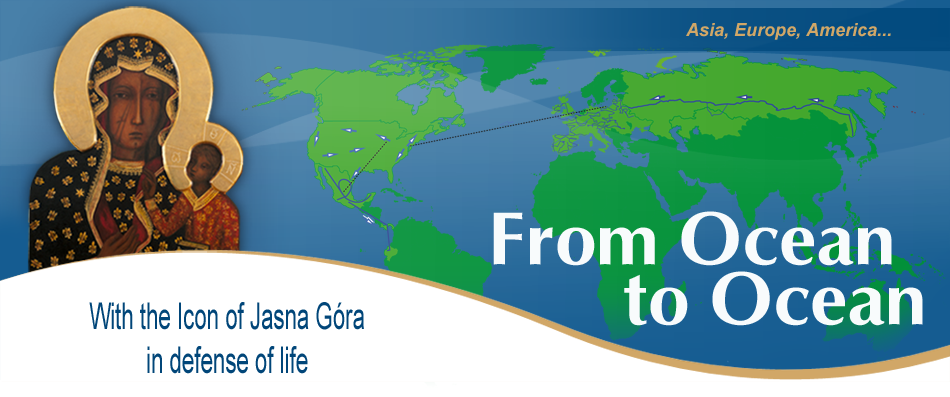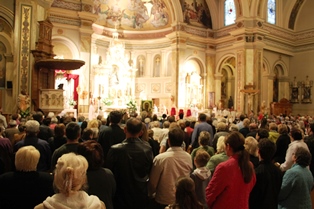As one of the oldest parishes in Chicago, St. Hyacinth's Basilica Minor had the particular privilege of hosting the Icon of Czestochowa on May 13th, thus on the 97th anniversary of the first apparition of Our Lady in Fatima, Portugal. The Icon arrived in Her Life Mobile, decorated with flowers.
Jan Słodyczka, a folk sculptor and the constructor of the Chicago version of Our Lady's vehicle, added a fanciful construction of a wooden crown to the top of the encasement in which Our Lady's Icon resides when traveling in the Life Mobile. The Icon stopped at the entrance to the basilica, next to a magnificent monument of St. John Paul II.
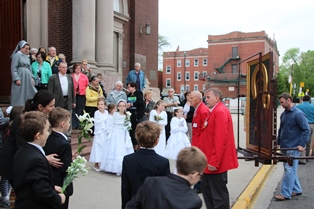
The Basilica of St. Hyacinth in Avondale is rich in history which goes back to the beginnings of the City of Chicago. The church was founded in 1894, when only forty Polish families lived in the area. "There was only a prairie here," says Father Stefan Róg CR, the Superior of the Resurrection Fathers. The then-Cardinal Karol Wojtyła celebrated the Holy Sacrifice of the Mass here in 1966, when he was still the Archbishop of Cracow, Poland.
The interior is decorated with stained glass windows, statues, stuccos, and frescos. The huge dome over the main nave is decorated with a fresco showing a group of saints and angels in Heaven. The main altar has a painted bar-relief representing an incident from the life of St. Hyacinth, the 13th century patron saint of the parish, who became a Dominican priest after meeting St. Dominic in Rome. He is called God's Apostle of the Slavonic peoples. During the Tartar's siege of Kiev, Father Hyacinth wanted to save a chalice with consecrated hosts from a church in Kiev, but he heard a statue of Our Lady say, "You have taken my Son and you leave me behind?" So he returned and took the heavy marble statue of Our Lady, which miraculously felt like a feather. He carried it to safety across the Dnieper on to Cracow, where he spent the remainder of his life and died in the ardor of sanctity on August 15, 1257.
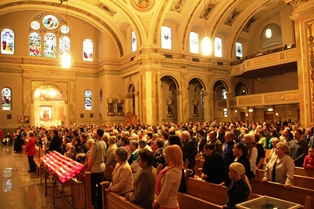
St. Hyacinth's has a parochial school (in English), a Saturday Polish school, and a Sunday religious formation program for all ages, and various other pastoral groups. The Resurrection Fathers also maintain a night shelter and a diner for the homeless, called The St. Lazarus Gate and a home for single mothers, where the Sisters Missionaries of Christ the King for Polish Immigrants help mothers and children in some of the most difficult life situations.
The solemn Holy Sacrifice of the Mass invoking the intercession of the Most Holy Virgin Mary was presided over by Fr. Dariusz Tabor CR, who also read the homily. Fr. Tabor concelebrated the Holy Mass with the Reverend Pastor Stanisław Jankowski CR, the pastor of the basilica, Fr. Adam Piasecki CR, Fr. Peter West, and a visiting priest from Cracow. They prayed for the protection of all human life, especially for the pregnant mothers and for married couples to have the determination to always protect the newly conceived life. In his homily, Fr. Dariusz reminded the congregation that Mary is called "The Throne of God" and as our Guide, She always leads us to Her Son.
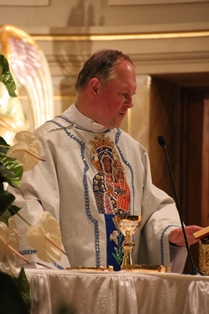
The veneration of the Icon lasted until midnight. As everywhere before, people formed a long line to approach the Icon. They were reciting the Mysteries of the Holy Rosary led by the parish priests. At 9:00 PM, the traditional Jasna Góra Appeal was sung. The prayerful veneration continued till 5:30 AM of the next morning. At 6:00 AM, the Holy Mass was celebrated in Polish and the Little Office of the Blessed Virgin Mary was sung. The following two Masses and the one at noon were celebrated in English and the homilies were given by Fr. Peter West of HLI.
At 8:00 AM, about 180 students of the parochial school of St Hyacinth came to meet Our Lady of Czestochowa in the Icon. At 3:00 PM, the Chaplet of Divine Mercy was prayed, followed by the Holy Rosary.
The visit of Our Lady closed with the May devotion prayer service, and after the singing of the hymn "Ciebie Boga wysławiamy" (We praise You, o God Almighty), the Icon of Our Lady was led to the Life Mobile where the delegation of the Holy Trinity parish was waiting to take the Icon along the streets of Chicago in an escort of motorcycles and cars decorated with flags.
